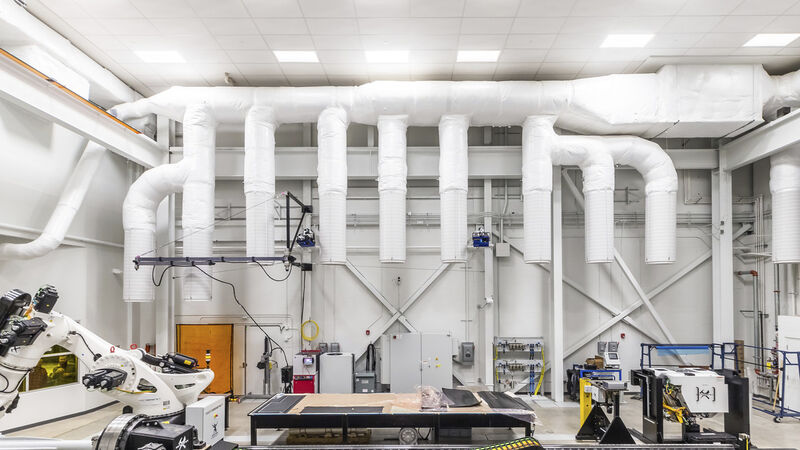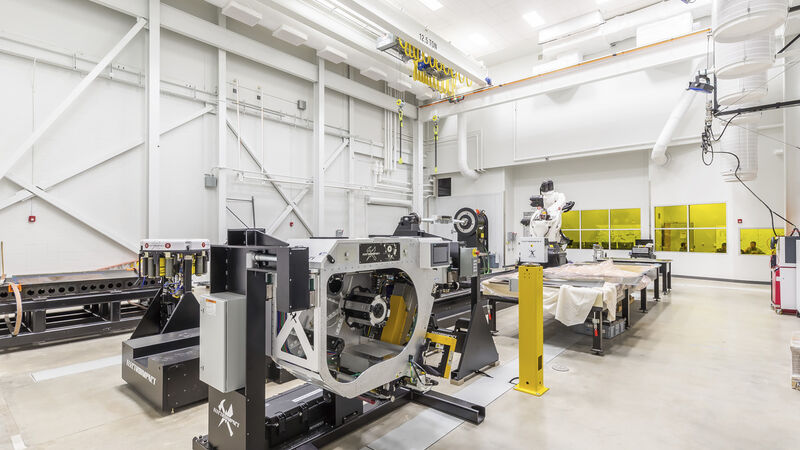
Wichita State University
National Institute for Aviation Research Laboratory Renovation and Addition
Industry-powered aerospace education, research, and development.
A dynamic American aerospace manufacturing hub, Wichita State University (WSU) is home to the National Institute for Aviation Research (NIAR), a research and development test facility partnering with industry innovators – including the Air Force Research Laboratory (AFRL), NASA, Federal Aviation Administration (FAA), U.S. Army, and U.S. Navy – to explore, create, and validate leading manufacturing concepts and designs.
Based on 2021 data compiled by the National Science Foundation, NIAR is currently first in industry-funded aerospace ventures and third in aeronautic research and development expenditures compared to other U.S. universities.
NIAR is home to 22 ground-breaking research laboratories spanning 1.6 million square feet, including the new Advanced Technologies Lab for Aerospace Systems (ATLAS). ATLAS is a core manufacturing technologies maker space, representing WSU’s continued dedication to its aviation roots.
Housing industry-size manufacturing equipment and advanced software, AEI – the engineer of record – transformed ATLAS’s Sector E high bay facility – previously used for crash test simulations – into an ISO Class 8 cleanroom conducting state-of-the-art carbon fiber layup research spanning approximately 4,000 square feet.
The project scope included mechanical, electrical, piping/plumbing, fire protection, instrumentation and controls, and technology engineering design services.

Dedicated custom air handling unit serving the cleanroom.
“ATLAS or the Advanced Technologies Lab for Aerospace Systems is set up as a maker space in the United States for advanced manufacturing research. Whether you are a small company or a big business, you have an idea, you can come to ATLAS without making a large capital expense. You can make your idea into a reality at ATLAS.”
AEI designed ATLAS Sector E to accommodate industry-size equipment, saving NIAR partners time and encouraging lean manufacturing – this means that partners don’t need to undertake extensive scaling studies to harness the technology and space at NIAR ATLAS.
Within the ATLAS Sector E cleanroom is a robotic electroimpact automated fiber placement (AFP) and automated tape laying (ATL) system with four interchangeable AFP heads and a class 4 laser.

ATLAS features a Coriolis automated fiber placement (AFP) system and an Electroimpact AFP system, shown above.

Using BIM and Revit software, AEI documented physical system design requirements including equipment, ductwork, piping, and conduit. A new mezzanine holds a dedicated air handling unit serving the cleanroom. The existing campus chilled water system did not have the capacity to support ATLAS Sector E’s cooling loads. To solve this, AEI incorporated a split direct expansion system to support cooling requirements.
ATLAS’ extensive equipment and capabilities include the following:
- Automated manufacturing
- High-fidelity inspections
- Structural tests & evaluations
- Computer-aided simulation & analysis
- Hands-on training & development
- #3
- Aerospace R&D Expenditures, National Science Foundation, 2021

NIAR ATLAS viewing room and operational hub - solving real-world aerospace challenges working with real-world aerospace manufacturers.
Protecting researchers and students while the laser is in operation, AEI designed safety interlocks and a viewing room, or operational hub, located directly outside the research space. The team designed the research space and viewing room with rigid temperature and humidity controls to meet ATLAS Sector E’s strict research requirements.
Recognized for their cutting-edge applied aerospace manufacturing capabilities and educational programs, NIAR’s ATLAS Sector E facility is equipped with building systems designed to accommodate advanced research technology while providing safe access for observation and study during system operation.
Beyond its role as an aerospace manufacturing powerhouse with industry-sized technology, NIAR boasts a robust engineering education program, offering undergraduate students and future engineers hands-on manufacturing and industry experience before entering the workforce.
